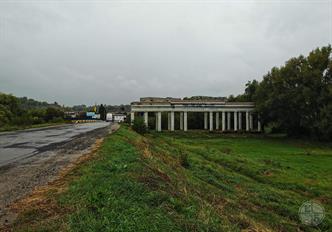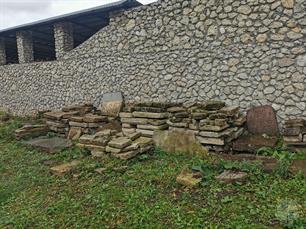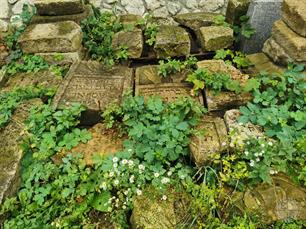Husyatyn
Chortkiv district, Ternopil region
Sources:
- George Aronson. A Brief History of the Jewish Community in Gusyatin, Ukraine
- Pinkas Hakehillot Polin: Encyclopedia of Jewish Communities, Poland, Volume II, published by Yad Vashem, Jerusalem;
- FB Group Husyatyn Istorychnyy
- Jewish encyclopedia of Brockhaus & Efron
- Russian Jewish encyclopedia
Photo:
- Eugene Shnaider
- Serhiy Martsinko
- George Aronson. A Brief History of the Jewish Community in Gusyatin, Ukraine
- Pinkas Hakehillot Polin: Encyclopedia of Jewish Communities, Poland, Volume II, published by Yad Vashem, Jerusalem;
- FB Group Husyatyn Istorychnyy
- Jewish encyclopedia of Brockhaus & Efron
- Russian Jewish encyclopedia
Photo:
- Eugene Shnaider
- Serhiy Martsinko
In 1559, King Sigismund II August granted Husyatyn Magdeburg law - the status of the city, permission to hold three fairs a year and weekly bidding on Mondays.
In 1645, the governor Chernihiv and the Fully Hetman - Marcin Kalinovsky Jr. built the castle and the Bernardin monastery.
In 1672, Turkey captured all Podillia. Husyatyn became the personal property of the governor of the Turkish Sultan; Onufrievsky Church was turned into a mosque.
In 1772, the western part of Husyatyn was under the rule of Austria. The Western Husyatyn is separated from the eastern and becomes the center of the county; East Husyatin is attached to Russia as a place of Kamenetz-Podolsky province.
Since November 1918, ZUNR (Western-Ukrainian People Republic) established in Husyatyn.
In the fall of 1920, Husyatyn was occupied by Polish troops.
In September 1939, the Red Army entered Husyatyn. In December 1939, the town became the district center.
In 1645, the governor Chernihiv and the Fully Hetman - Marcin Kalinovsky Jr. built the castle and the Bernardin monastery.
In 1672, Turkey captured all Podillia. Husyatyn became the personal property of the governor of the Turkish Sultan; Onufrievsky Church was turned into a mosque.
In 1772, the western part of Husyatyn was under the rule of Austria. The Western Husyatyn is separated from the eastern and becomes the center of the county; East Husyatin is attached to Russia as a place of Kamenetz-Podolsky province.
Since November 1918, ZUNR (Western-Ukrainian People Republic) established in Husyatyn.
In the fall of 1920, Husyatyn was occupied by Polish troops.
In September 1939, the Red Army entered Husyatyn. In December 1939, the town became the district center.
 |
 |
| The arch is the border between two Hysyatins. And once it was the border between the empires | Bernardin monastery |
On July 6, 1941, Husyatyn was conquered by the German Army. Immediately, the local Ukranians began to attack the local Jews.
The community was burdened by forced labor and confiscation of property. Many died of hunger and disease.
Finally, in March 1942, the remaining Jews of Husyatyn were rounded up by the Nazis and deported by train to Kofichintza and Provozna, never to return. So ended 500 years of Jewish life in Husyatyn.
The community was burdened by forced labor and confiscation of property. Many died of hunger and disease.
Finally, in March 1942, the remaining Jews of Husyatyn were rounded up by the Nazis and deported by train to Kofichintza and Provozna, never to return. So ended 500 years of Jewish life in Husyatyn.
The history of the Jewish community in Husyatyn spans more than 500 years from its early origins as a farm in the sixteenth century. The community reached its peak in the late 1800s, when Husyatyn was both a thriving commercial center and one of the most important Hassidic centers in Galicia. Sadly, the golden age did not last for long. Husyatyn was heavily damaged during World War I, then destroyed during World War II.
Jews were among the first to settle in Husyatyn after its incorporation as a town in 1559. There are records of a synagogue in Husyatyn by the start of the seventeenth century. The community was small and vulnerable, however, and suffered from anti-semitic activity. In 1623, three Jewish farmers, brothers, were accused of murdering Christian children; they were prosecuted, tortured and burnt at the stake. Cossacks conquered the town in 1648, although not much is known of the fate of the town's Jews at that time.
The Jewish community revived and began to prosper from 1680 through 1699, when Turkey conquered and ruled Galicia. By the end of the seventeenth century, the Jewish community had built a beautiful new synagogue. The building of the new synagogue was challenged in court by Bishop Sharkovski of Kamenetz-Podolski, who claimed that the synagogue should not have been built without his approval. In 1729, the local nobility, the Pototzki family, intervened to dismiss the court suit in order to protect the Jews that lived on their land. The Jewish community grew modestly under Polish rule in the first half of the eighteenth century, reaching 1,208 by 1765.
Jews were among the first to settle in Husyatyn after its incorporation as a town in 1559. There are records of a synagogue in Husyatyn by the start of the seventeenth century. The community was small and vulnerable, however, and suffered from anti-semitic activity. In 1623, three Jewish farmers, brothers, were accused of murdering Christian children; they were prosecuted, tortured and burnt at the stake. Cossacks conquered the town in 1648, although not much is known of the fate of the town's Jews at that time.
The Jewish community revived and began to prosper from 1680 through 1699, when Turkey conquered and ruled Galicia. By the end of the seventeenth century, the Jewish community had built a beautiful new synagogue. The building of the new synagogue was challenged in court by Bishop Sharkovski of Kamenetz-Podolski, who claimed that the synagogue should not have been built without his approval. In 1729, the local nobility, the Pototzki family, intervened to dismiss the court suit in order to protect the Jews that lived on their land. The Jewish community grew modestly under Polish rule in the first half of the eighteenth century, reaching 1,208 by 1765.
 |
 |
 |
| Synagogue in Husyatyn, 2021 | Interior of synagogue, 2021 | |
 |
 |
 |
| On the roof of synagogue | Synagogue in Husyatyn, beg. 20 century |
In 1772, Husyatyn was divided into two sections when Poland was partitioned between Austria and Russia. Most of the Jewish community lived in developed areas west of the Zabrotz River, ruled by Austria, although some Jews lived in the smaller portion of the town east of the river, ruled by Russia.
As a border town, Husyatyn became an important path for trade between Austria and Russia, and merchants came from surrounding areas to trade in fairs in the town. At this time, most of the Jews in Husyatin were craftsmen or wholesale merchants. Many sold or shipped grain and lumber to Russia.
In the 1800s, Hassidim began to move to Husyatyn, including followers of Rabbi Nahman of Bratslav.
The Hassidic population growth sharply after Rabbi Mordecai Shraga-Bar, son of Rabbi Israel of Rozhin, established a Hassidic Court in Husyatyn in 1861. Hundreds of Hassidim moved to Husyatyn to be near the rebbe, fueling the rise of a local hospitality industry.
Rabbi Mordecai befriended the local nobility, the Marquis Golokhovski, and the whole area prospered. An elegant study house was built for the rebbe on the grounds of a partially ruined castle. New synagogues were built, as were ritual baths, hospitals and old age homes.
The town supported new industries, including a Jewish-owned factory to make fountain pen nibs, print shops and paper merchants, as well as doctors, lawyers and other professionals.
The town was hurt by a major cholera epidemic in 1870, but growth resumed with the opening of the railroad connection to Stanislavov in 1882 and the influx of refugees from Russia at that time.
As a border town, Husyatyn became an important path for trade between Austria and Russia, and merchants came from surrounding areas to trade in fairs in the town. At this time, most of the Jews in Husyatin were craftsmen or wholesale merchants. Many sold or shipped grain and lumber to Russia.
In the 1800s, Hassidim began to move to Husyatyn, including followers of Rabbi Nahman of Bratslav.
The Hassidic population growth sharply after Rabbi Mordecai Shraga-Bar, son of Rabbi Israel of Rozhin, established a Hassidic Court in Husyatyn in 1861. Hundreds of Hassidim moved to Husyatyn to be near the rebbe, fueling the rise of a local hospitality industry.
Rabbi Mordecai befriended the local nobility, the Marquis Golokhovski, and the whole area prospered. An elegant study house was built for the rebbe on the grounds of a partially ruined castle. New synagogues were built, as were ritual baths, hospitals and old age homes.
The town supported new industries, including a Jewish-owned factory to make fountain pen nibs, print shops and paper merchants, as well as doctors, lawyers and other professionals.
The town was hurt by a major cholera epidemic in 1870, but growth resumed with the opening of the railroad connection to Stanislavov in 1882 and the influx of refugees from Russia at that time.
The turn of the century was the golden age for Husyatyn, with Jews comprising 4197 of the town's 6060 residents in 1890. Hassidism thrived. Zionist groups were started, including Bnai Zion and a Theodore Herzl group. A Toynbee-Hala club was established to present popular lectures on Saturday evenings. An organization called Dorshei Sefat Yeshanim was founded to republish rare manuscripts. Modern services came to the town, including banks, electricity and a new sewage system.
The town's growth was haunted by the prospects of war between Austria and Russia. The flow of refugees increased, especially in 1903-1906. Crossing the border became more difficult. Fearing the war, Husyatyn residents also began to emigrate. By 1914, the Hassidic Rebbe of that time, Rabbi Israel, moved to Vienna and closed the Hassidic Court, putting an end to the golden age.
The town's growth was haunted by the prospects of war between Austria and Russia. The flow of refugees increased, especially in 1903-1906. Crossing the border became more difficult. Fearing the war, Husyatyn residents also began to emigrate. By 1914, the Hassidic Rebbe of that time, Rabbi Israel, moved to Vienna and closed the Hassidic Court, putting an end to the golden age.
On August 9, 1914, the Russian Army crossed the Zabrotz River and attacked Austria through Husyatyn. Fires in the town destroyed more than 600 buildings. The Jews dispersed among neighboring towns and villages to avoid the oncoming armies.
Many died from typhus as local conditions deteriorated.
Jews were ordered out of Husyatyn in on June 13, 1915, but many made their way back into the town.
When the Russian Army retreated in 1916, the remaining Jews were ordered into exile again, this time to the Kiev district of Russia.
Raids from peasant gangs plagued the few Jews that returned to the town after the war in 1918 to 1919. Then the Bolsheviks came to power and confiscated property from Jewish-owned businesses. By 1921, the Jewish population had declined to 368, less than 10 percent of the peak population in 1890.
Many died from typhus as local conditions deteriorated.
Jews were ordered out of Husyatyn in on June 13, 1915, but many made their way back into the town.
When the Russian Army retreated in 1916, the remaining Jews were ordered into exile again, this time to the Kiev district of Russia.
Raids from peasant gangs plagued the few Jews that returned to the town after the war in 1918 to 1919. Then the Bolsheviks came to power and confiscated property from Jewish-owned businesses. By 1921, the Jewish population had declined to 368, less than 10 percent of the peak population in 1890.
The Jewish community of Husyatyn never recovered from World War I. The town continued to be divided by an international border, this time between Poland and Russia. All commerce with Russia was stopped by travel restrictions.
The Hassidim center was closed. The electric lighting system was not repaired.
Yet, some Jewish life continued despite the decline. A rabbi was hired (Rabbi Jacob Ringel). A Hebrew school continued to operate. The ritual bath was repaired.
Husyatyn was the home of several active Zionist groups, including Hitachdut (Labor Party), Mizrachi, and Revisionists. And although contact between the Polish and Russian portions of the community was prohibited, each Rosh Hashanah, the Jews of Polish Husyatyn and Russian Husiatyn would go to the banks of the Zabrotz River for the Tashlich prayer, the only time during the year when they were allowed to see and speak with each other.
The Hassidim center was closed. The electric lighting system was not repaired.
Yet, some Jewish life continued despite the decline. A rabbi was hired (Rabbi Jacob Ringel). A Hebrew school continued to operate. The ritual bath was repaired.
Husyatyn was the home of several active Zionist groups, including Hitachdut (Labor Party), Mizrachi, and Revisionists. And although contact between the Polish and Russian portions of the community was prohibited, each Rosh Hashanah, the Jews of Polish Husyatyn and Russian Husiatyn would go to the banks of the Zabrotz River for the Tashlich prayer, the only time during the year when they were allowed to see and speak with each other.
 |
 |
| Matsevot in Soviet times used as building material | This is a retaining wall on the outskirts of town |
And a some local attractions. Among them is the former house of the Husyatyn's branch of the Sokol (Falcon) gymnastic society and several other buildings in the Secession style, popular at the turn of the 19-20 centuries.

- Home
- Shtetls
- Vinnytsia region
- Volyn region
- Dnipro region
- Donetsk region
- Zhytomyr region
- Zakarpattia region
- Zaporizhzhia region
- Ivano-Frankivsk region
- Kyiv region
- Kropyvnytskyi region
- Luhansk region
- Lviv region
- Mykolayiv region
- Odessa region
- Poltava region
- Rivne region
- Sumy region
- Ternopil region
- Kharkiv region
- Kherson region
- Khmelnytskyi region
- Chernihiv region
- Chernivtsi region
- Cherkasy region
- Crimea
- Synagogues
- Cemeteries
- Objects & guides
- Old photos
- History
- Contact
Jewish towns of Ukraine
Jewish towns of Ukraine
My shtetl
My shtetl
Donate





















